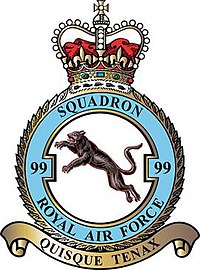No. 99 Squadron RAF
| No. 99 Squadron Royal Air Force | |
|---|---|
 |
|
| Active | 15 August 1917 – 2 April 1920 1 April 1924 – 15 November 1945 17 November 1947 – 7 January 1976 1 January 2002 – present Day |
| Country |
|
| Branch |
|
| Base | RAF Brize Norton |
| Nickname(s) | Madras Presidency |
| Motto(s) |
Latin: Quisque tenax (Translation:"Each tenacious") |
| Battle honours | Western Front, 1917–1918* Independent Force & Germany, 1918* Mahsud, 1919–1920 Waziristan, 1919–1920 German Ports, 1940–1941 Baltic, 1940–1941 France & Low Countries, 1940 Fortress Europe, 1940–1942* Ruhr, 1940–1942* Berlin, 1940–42* Biscay Ports, 1940 Arakan, 1942–44 Burma, 1944–45 Manipur, 1944 Eastern Waters 1945. Honours marked with an asterix (*) are those emblazoned on the squadron standard. |
| Commanders | |
| Current commander |
W/Cdr. Rhodri Evans |
| Insignia | |
| Squadron Badge heraldry | A Puma salient The squadrons first aircraft had Puma engines, the cat chosen for independence and tenacity while the black colour signifies the night-bombing role |
| Squadron Codes |
VF (Apr 1939 – Sep 1939) LN (Sep 1939 – Feb 1942) |
No. 99 Squadron is a squadron of the Royal Air Force which operates the Boeing C-17 Globemaster III strategic/tactical transport aircraft from RAF Brize Norton.
The squadron conducts global deployments on behalf of the British Armed Forces and the UK Government, notably delivering emergency aid during natural disasters and supporting military operations overseas.
No. 99 was a bomber squadron in both World War I and World War II. The squadron was the first RAF unit to receive the Avro Aldershot, Handley Page Hyderabad, Handley Page Hinaidi, Vickers Wellington, Bristol Britannia and Boeing Globemaster. In case of the Avro Aldershot the squadron was its only operator, as it is now for the Globemasters.
What would later become No. 99 (Madras Presidency) Squadron was originally formed at Yatesbury, Wiltshire, England on 15 August 1917 from elements supplied by No. 13 Training Squadron, RFC. It was equipped with de Havilland DH.9 bombers in 1918, deploying to France to form part of the Independent Air Force, the RAF's strategic bombing force. It flew its first mission on 21 May and continued to take part in large scale daylight raids against targets in Germany, sustaining heavy losses both due to the unreliable nature of the DH.9 and heavy German opposition. As an example, during one raid against railway targets in Saarbrücken on 31 July 1918, seven out of nine aircraft from 99 Squadron were shot down, with a further three DH.9s turning back with engine trouble before the formation crossed the enemy lines 99 Squadron was withdrawn from the front line on 25 September to be re-equipped with de Havilland DH.9A bombers, and it was still in the process of converting when the war ended. During the war it had taken part in 76 bombing raids, dropping 61 tons of bombs and claiming 12 German aircraft, of which eight were during the raid of 31 July.
...
Wikipedia
